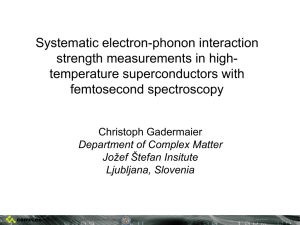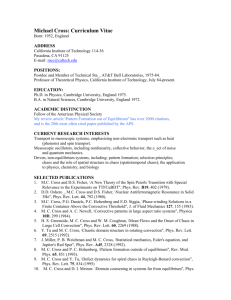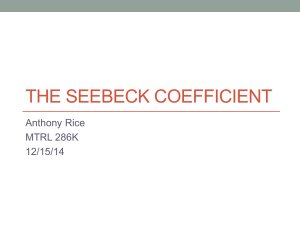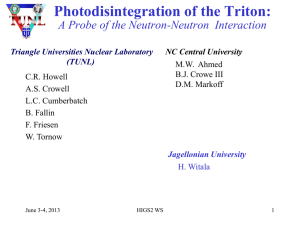A Quantum Mechanical Treatment of the Contribution of
advertisement
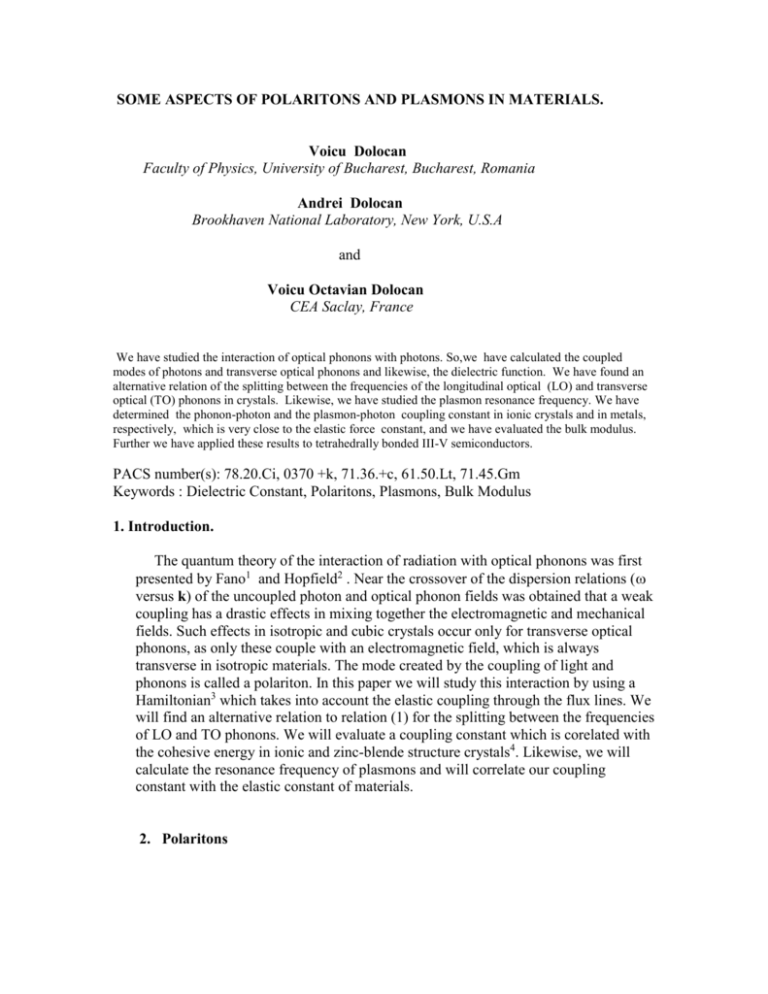
SOME ASPECTS OF POLARITONS AND PLASMONS IN MATERIALS. Voicu Dolocan Faculty of Physics, University of Bucharest, Bucharest, Romania Andrei Dolocan Brookhaven National Laboratory, New York, U.S.A and Voicu Octavian Dolocan CEA Saclay, France We have studied the interaction of optical phonons with photons. So,we have calculated the coupled modes of photons and transverse optical phonons and likewise, the dielectric function. We have found an alternative relation of the splitting between the frequencies of the longitudinal optical (LO) and transverse optical (TO) phonons in crystals. Likewise, we have studied the plasmon resonance frequency. We have determined the phonon-photon and the plasmon-photon coupling constant in ionic crystals and in metals, respectively, which is very close to the elastic force constant, and we have evaluated the bulk modulus. Further we have applied these results to tetrahedrally bonded III-V semiconductors. PACS number(s): 78.20.Ci, 0370 +k, 71.36.+c, 61.50.Lt, 71.45.Gm Keywords : Dielectric Constant, Polaritons, Plasmons, Bulk Modulus 1. Introduction. The quantum theory of the interaction of radiation with optical phonons was first presented by Fano1 and Hopfield2 . Near the crossover of the dispersion relations ( versus k) of the uncoupled photon and optical phonon fields was obtained that a weak coupling has a drastic effects in mixing together the electromagnetic and mechanical fields. Such effects in isotropic and cubic crystals occur only for transverse optical phonons, as only these couple with an electromagnetic field, which is always transverse in isotropic materials. The mode created by the coupling of light and phonons is called a polariton. In this paper we will study this interaction by using a Hamiltonian3 which takes into account the elastic coupling through the flux lines. We will find an alternative relation to relation (1) for the splitting between the frequencies of LO and TO phonons. We will evaluate a coupling constant which is corelated with the cohesive energy in ionic and zinc-blende structure crystals4. Likewise, we will calculate the resonance frequency of plasmons and will correlate our coupling constant with the elastic constant of materials. 2. Polaritons 2 We imagine that two phonons interact between them via electromagnetic field and likewise, two photons interact via mechanical field. The total Hamiltonian of the interacting bodies and the connecting field is H Ho HI H o H o1 H o 2 q bq bq k ak ak q (1) k D u u n c dz 2 n z 2 HI where q 2m q 1 u n (z ) N 1 u c (z ) ( NR)1 / 2 k2 DRk 2 1/ 2 b q k 2 k 1/ 2 o ; bq e i q ( z z n ) (ak a k )e i k z ( 2) DR c2 where un(z) is the relative displacement of the two bodies oriented along the axis connecting them, uc(z) = e.uc(z) is the displacement of the connecting field ( e is the polarization vector), q, k are just the classical oscillation frequencies, ak+, ak and bq+, bq are boson creation and annihilation operators for the connecting filed and the interacting bodies, respectively. N is the number of the bodies, which have the same mass m and, in the equilibrium positions, lie at a distance R from one another, oR = mo is the mass associated with the interacting field , if this is a massive field, c is the light velocity, is the restoring force constant and D is a coupling constant6. May be written D HI 2 n ,k ,k ',q 2m q 1/ 2 b q bq e i q.z n (3) 1 k.k ' ak a k a k ' ak' e i (k k ' q ) z dz 1/ 2 NR 2 ( k k ' ) Consider the integral over z e i ( k k ' q ) z dz NR k k 'q and therefore, k’ = k + q. (4) 2 The Hamiltonian of the system is H q bq bq k ak ak Ak ,q (bq a q bq aq k ,q q q b a q b a where Ak ,q q (5) DN o 2 N 1/ 2 k (k q) k k q 1 / 2 2m q 1/ 2 1 1/ 2 N e n i q.z n (6) We consider the interaction of the optical phonons with photons of the electromagnetic field. This interaction is particularly important when the frequencies and wave vectors of the phonon and photon fields coincide - near the crossover of the dispersion relations even weak coupling of two fields can have drastic effects. Such effects in isotropic or cubic crystals occur only for transverse optical phonons, as only these couple with an electromagnetic field, which is always transverse in isotropic media. Therefore, we assume that our system is formed from phonons and photons with k = q. The Hamiltonian (6) may be diagonalized and one obtains c q c q 4 2 o 2 2 2 2 o 2 2 4 o cq A 2 2 0 (7) Here A is given by Eq. (6), ≡k is the optical phonon frequency, which is the longitudinal optical frequency, L, and q = cq is the photon frequency, where c is the light velocity. To include the electronic polarizability we will replace c2 by c2/ ∞ where ∞ is the square of the optical refractive index. We write equation (7) in the form c2q2 c2q2 L2 4 2 2 1/ 2 2 4 L A 0 L 2 cq (8) By comparing this equation with standard equation 4 2 L2 we identify c 2 q 2 c 2 q 2T2 0 (9) 4 4 L A 1 / 2 2 2 T 2 L (10) 2 cq This relation may be compared with standard relation which gives the splitting between the frequencies of the longitudinal optical (LO) and transverse optical (TO) phonons in diatomic crystals may be written5-10 L2 T2 Ne *2 s M r where e* is an effective electronic charge per ion and is defined by 1 1 e *2 M r oo2 o s N is the number of unit cells per unit volume, s is the low frequency (static) dielectric constant, o is the free space permitivity, ∞ is the high frequency dielectric constant, Mr is the reduced mass of the two atoms, o is the unit cell volume, o2 = 2/Mr , is the force constant of the material. This difference, at k = 0, arises from the ionicity of the crystal. For group IV semiconductors there is, of course, no splitting at k = 0 between the longitudinal and transverse frequencies. The above relations are defined on the basis of the concept of macroscopic electric polarization11-17 The existence of polaritons is related to the condition q.R < 1, so that the relations (27) are generally fulfilled. From the above expressions we see that the difference L2 - T2 depends on the wave vector q. Now, we assume that both processes of interaction between two phonons via photons and vice-versa, occur simultaneous . In this case one obtains 21 / 2 D 2 L R 2 1 / 2 1 c1 / 2 M r3 / 2T3 / 2 N 1 / 2 2 L 2 T e 2 i q.z n (11) n which for q.R < 1 do not depend on q. In this case, for a cubic crystal the modulus square in this expression equals 12 for NaCl structures and equals 16 for CsCl structures; for an isotropic medium it equals to unity. By using the relation between the constant D and bulk modulus, we evaluate from relation (11) the value of R = 8Ro for all structures . 3. The resonance frequency of plasmons. 5 We now consider briefly the dielectric constant associated with the uniform plasma mode18-24. In this case we replace L = p ( resonance frequency of plasmons) in Eq.(8) and we take 4 p A 1 / 2 2 2 p 2 cq 0 (12) because the transverse mode eigen frequencies are zero. Therefore, Eq. (8) becomes 2 p2 c2q2 0 (13) and ( ) c2q2 2 p2 2 (14) In order to determine the plasmon-photon interaction constant, D, in the expressions of ׀A׀2 we replace T by p and Mr by m/2 where m is the electron effective mass. In this case, instead of Eq. (11) we have 5/ 2 p 4 D 2 R 2 1 / 2 1 c1 / 2 m 3 / 2 N 1 / 2 e 2 iq.z n (15) n Fot q.R <<1 the modulus square in this expression equals 12 for NaCl structures, equals 16 for bcc structures, equals 24 for fcc and hc structures and equals 8 for diamond structures. . In this case we have evaluated the plasmon-photon interaction constant D for some materials. zv is the number of the valence electrons. In metals we have considered R = 16rs , where rs is the radius of the sphere containing one free electron 4rs3 zv V 3 where V is the volume occupied by an atom in the crystal. One obtains rs = Ro/2.55 for sodium chloride structures and rs = Ro/2.2 for diamond structures. For sodium chloride structure we take R = 8rs.Likewise, we have presented the results for diamond structures Sn, C, Si and Ge. 6. Conclusions. By using a Hamiltonian of interaction based on the elastic coupling through flux lines, we have found a new relation between the longitudinal and transverse optical phonon frequencies. We used this relation for determination of the constant coupling D which coincides with the elastic force constant. On this basis we evaluate the bulk modulus and cohesive energy for ionic and zinc-blende crystals. We have applied the obtained formula to plasmons in metals and some ionic and covalent crystals and we have calculated the bulk modulus. The obtained results are in a good agreement with experimental data. We would believe that the elastic coupling is a general interaction in the nature ? References 1. U. Fano, Phys. Rev. 103 (1956) 1202. 2. J. J. Hopfield, Phys.Rev. 112 (1958) 1555. 3. A. Dolocan and V. Dolocan, Int. J. Mod. Phys. B16 (2002) 4809; B17 (2003) 4763. 4. H. Schlosser, J. Phys. Chem. Solids, 53 (1992) 855 5. A. Proca, J. Phys. Radium, 7 (1936) 347. 6. V. Dolocan, Z. Phys. B101 (1996) 583; Phys. Rev, B57 (1998) 5394; J.Superconductivity, 11 (1998) 409; Romanian J. Phys. 44 (1999) 679. 7. G. Lukovsky, R. M. Martin and E. Burstein, Phys. Rev. B4 (1971) 1364. 8. M. Born and K. Huang, Dynamical Theory of Crystal Lattices (Clarendon, Oxford, England,1954), chap.2. 9. J.C.Philips, Rev. Mod. Phys. 42 (1970) 317. 10. S. Nagasaka and T. Kojima, J. Phys. Soc. Jap. 56 (1987) 408. 11. W. Shong, R. D. King-Smith and D. Vanderbilt, Phys. Rev. Lett. 72 (1994)3618. 12. R. Resta, Rev. Mod. Phys. 66 (1994) 899. 13. W. A. Harrison, Phys.Rev. B74 (2006) 205101 14. V. Dolocan, A. Dolocan and V.O. Dolocan, Mod. Phys. Lett., B22 (2008), to be published. 15) W. B. Pearson, The Crystal Chemistry and Physics of Metals and Alloys (WileyIntersciences, New York, 1972). 16) H. Schlosser, J. Ferrante and J. B. Smith, Phys. Rev. B44 (1991) 9696. 7 17) L. Pauling, The Nature of The Chemical Bond, Cornell U. P., Ithaca, N. Y., 1939). 18) Yan Li, L. Zhang, T. Cui, Y. Ma, G. Zou and D. D. Klug, Phys. Rev B74 (2006) 054102 19) F. Tran, L. Laskoroski, P. Blaha and K. Schwarz, Phys. Rev. B75 (2007) 115131. 20) D. Powell, M. A. Migliorato and A. G. Cullis, Phys. Rev. B75 (2007) 115202. 21) X. D. Dai, Y. Kong and J. H. Li, Phys. Rev. B75 (2007) 104101. 22) J. Zhang, L. Zhang, T. Cui, Y. Li, Z. He, Y. Ma, G. Zou, Phys. Rev. B75 (2007) 104115. 23) D. Pines and P. Nozières , The Theory of Quantum Liquids ( W. A. Benjamin, Inc., New York, 1966). 24) J. M. Rose, J. R. Smith, F. Guinea and J. Ferrante, Phys. Rev. B29 (1984) 2963. 18 Figure Captions. Fig.1. The configuration of the flux lines connecting the bodies. un is the displacement of a body and uc is the displacement of the flux line.
